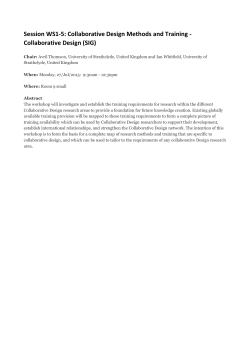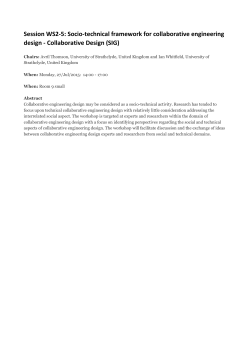
How to Organize Alliances of Multiple Organizations: Part 2 NONPROFIT MANAGEMENT
NONPROFIT MANAGEMENT How to Organize Alliances of Multiple Organizations: Part 2 A governance structure for networks seeking to achieve collective impact. By Christopher Keevil & John Martin | Mar. 15, 2012 How to Organize Alliances of Multiple Organizations A governance structure for large networks of organizations seeking to achieve collective impact. How to Organize Alliances of Multiple Organizations: Part 1 How to Organize Alliances of Multiple Organizations: Part 2 T he members of the New Britain Early Childhood Collaborative—heads of local nonprofits, board of education officials, foundation representatives, parents, academics, and community organizers—had a vision. In New Britain, Connecticut, only 36 percent of third-graders read at grade level and only 10 percent of children entering kindergarten were assessed as fully ready. The rate of low-birth-weight babies was high, yet by age three, more than half of children entering Head Start preschools were overweight or obese. The city’s teen pregnancy rate was 2 ½ times the state average and births to women without a high school degree was twice the state average. Collaborative members wrote “A Blueprint for Improving the Lives of New Britain’s Young Children” that set five ambitious goals: • All of New Britain’s babies would be born at a healthy weight. • All mothers would attain a high school diploma. • All preschoolers would be in a healthy weight range. • All children would be ready for kindergarten. • All children would read at grade level by the end of third grade. Initial work toward these goals seemed promising. Books were distributed to young mothers to read to their preschool children. Sub-committees were defined, meetings were held. And excitement rose when five state and national funders together gave the collaborative a three-year grant of $250,000. But a year later, collaborative members had grown frustrated and concerned. Implementation of the blueprint had stalled; momentum was slipping away. People were unclear about what they were supposed to do. Fewer people were involved, and top community leaders had stepped away. The achievement of the blueprint’s goals felt like a distant dream. Luckily, the collaborative had retained both its vision for New Britain’s children and the community’s good will. They designed and implemented a new structure to strengthen their work, which draws on elements we have observed in other successful alliances: an executive council, a leadership team, program management teams that create discrete projects, project work groups, support staff, and deliberate means for involving the broader community. The president of the Community Foundation of Greater New Britain, New Britain’s mayor, and the acting superintendent of schools are working to form the executive council. They are seeking to include the president of the local state university, local business leaders, and other key leaders in the community of New Britain. The executive council would make sure the collaborative has the support it needs to accomplish its goals. Replacing the various subcommittees that had been formed to manage discrete aspects of the work, the collaborative’s new Blueprint Leadership Team sets priorities, allocates resources, invites participants, and ultimately ensures that the collaborative accomplishes its goals. In addition to some of those who had written the blueprint, the collaborative augmented this core team with leaders of community groups, parent organizations and nonprofits that had been missing before. For the most part, those who joined the collaborative did so as part of their regular jobs—their employer organizations recognizing that this would allow the organization to achieve more than it could on its own. The leadership team delineated three program areas to achieve its goals—health and safety, early learning, and family literacy—and established a program management team composed of members of organizations who shared the collaborative’s goals to lead each area. Program management teams, in turn, defined a set of projects with start dates, end dates, deliverables, and metrics to track success. Some of these drew on the existing community; for example, the family literacy team called upon nonprofits providing adult literacy services to teach mothers to read to their children at home. Others, such as the health and safety team’s initiative to prevent early childhood obesity through interventions at family health clinics, were new. To implement these projects, each program management team formed a set of project work groups. Each project work group was responsible to carry out the work of its project, such as conducting literacy training or developing healthy eating manuals. Each would also gather data on progress and report results back to the program management team. Based on this structure, the collaborative identified two critical paid staff roles. An executive coordinator would attend all key meetings and keep everyone informed, bring other relevant organizations into the fold, and disseminate information on the collaborative’s progress to the broader New Britain community. And an operational coordinator would support the project work groups, help analyze data on the collaborative’s progress, and prepare reports to funders. Both staff members would report to the chair of the Blueprint Leadership Team. Additionally, the funders paid for a technical assistance team—two consultants skilled in organizational development and community building—to assist the collaborative on an ongoing basis. Cultural differences had stalled several programs in the past, so the collaborative developed mechanisms for community engagement. It actively recruited members of the New Britain community who had not participated in the collaborative—especially from the Hispanic, African American, Arab, and Polish communities—to join the new teams. It convened ad hoc insight groups from the local community, to provide input on the priorities and approaches of work groups to help make the work relevant and useful to the communities the programs served. And, it planned advisory groups of business and civic leaders who cared about the collaborative’s goals and could provide support and guidance. The diagram below shows the organizational structure that the collaborative developed, including each of the groups that make up the collaborative and the accountability relationships between them, to make its goals a reality. Implementing this new governance structure helped the collaborative take off. Enthusiasm and energy grew. People were clearer about their roles and what they were there to accomplish. Partnerships with related programs in the community became easier. Community leaders engaged. And people from a broader array of cultures, ethnicities, and social arenas became more active in the work. While accomplishing the collaborative’s ultimate goal would still take time, they had turned a corner on a path to achieving meaningful results. Christopher Keevil is the founder and managing director of Wellspring Consulting, a strategy consulting firm for the nonprofit sector. Prior to founding Wellspring Consulting, he was a partner at The Boston Consulting Group. John Martin is a senior consultant with Wellspring Consulting. Before joining Wellspring Consulting, he was an associate with L.E.K. Consulting and has held multiple management positions within the nonprofit sector. Tags Leadership C o pyr i g h t © 2012 If you like this article enough to print it, be sure to subscribe to SSIR!
© Copyright 2025





















